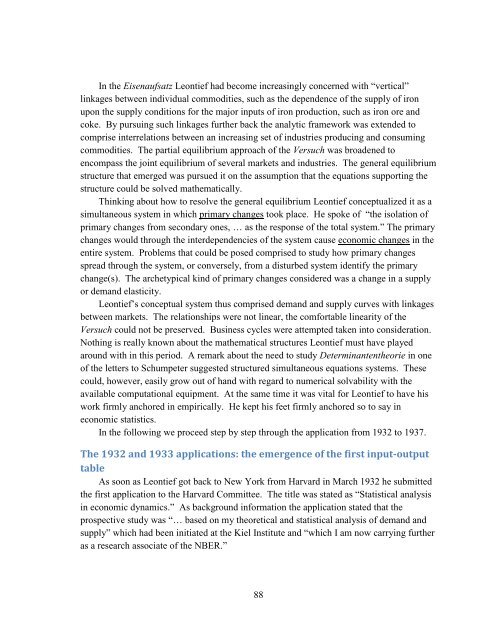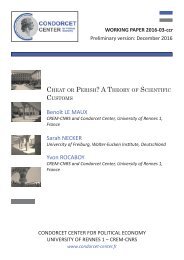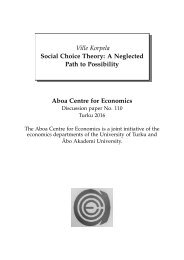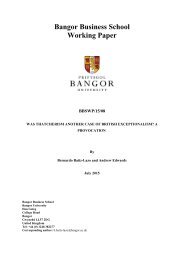MEMORANDUM
n?u=RePEc:hhs:osloec:2016_018&r=hpe
n?u=RePEc:hhs:osloec:2016_018&r=hpe
Create successful ePaper yourself
Turn your PDF publications into a flip-book with our unique Google optimized e-Paper software.
In the Eisenaufsatz Leontief had become increasingly concerned with “vertical”<br />
linkages between individual commodities, such as the dependence of the supply of iron<br />
upon the supply conditions for the major inputs of iron production, such as iron ore and<br />
coke. By pursuing such linkages further back the analytic framework was extended to<br />
comprise interrelations between an increasing set of industries producing and consuming<br />
commodities. The partial equilibrium approach of the Versuch was broadened to<br />
encompass the joint equilibrium of several markets and industries. The general equilibrium<br />
structure that emerged was pursued it on the assumption that the equations supporting the<br />
structure could be solved mathematically.<br />
Thinking about how to resolve the general equilibrium Leontief conceptualized it as a<br />
simultaneous system in which primary changes took place. He spoke of “the isolation of<br />
primary changes from secondary ones, … as the response of the total system.” The primary<br />
changes would through the interdependencies of the system cause economic changes in the<br />
entire system. Problems that could be posed comprised to study how primary changes<br />
spread through the system, or conversely, from a disturbed system identify the primary<br />
change(s). The archetypical kind of primary changes considered was a change in a supply<br />
or demand elasticity.<br />
Leontief’s conceptual system thus comprised demand and supply curves with linkages<br />
between markets. The relationships were not linear, the comfortable linearity of the<br />
Versuch could not be preserved. Business cycles were attempted taken into consideration.<br />
Nothing is really known about the mathematical structures Leontief must have played<br />
around with in this period. A remark about the need to study Determinantentheorie in one<br />
of the letters to Schumpeter suggested structured simultaneous equations systems. These<br />
could, however, easily grow out of hand with regard to numerical solvability with the<br />
available computational equipment. At the same time it was vital for Leontief to have his<br />
work firmly anchored in empirically. He kept his feet firmly anchored so to say in<br />
economic statistics.<br />
In the following we proceed step by step through the application from 1932 to 1937.<br />
The 1932 and 1933 applications: the emergence of the first input-output<br />
table<br />
As soon as Leontief got back to New York from Harvard in March 1932 he submitted<br />
the first application to the Harvard Committee. The title was stated as “Statistical analysis<br />
in economic dynamics.” As background information the application stated that the<br />
prospective study was “… based on my theoretical and statistical analysis of demand and<br />
supply” which had been initiated at the Kiel Institute and “which I am now carrying further<br />
as a research associate of the NBER.”<br />
88





